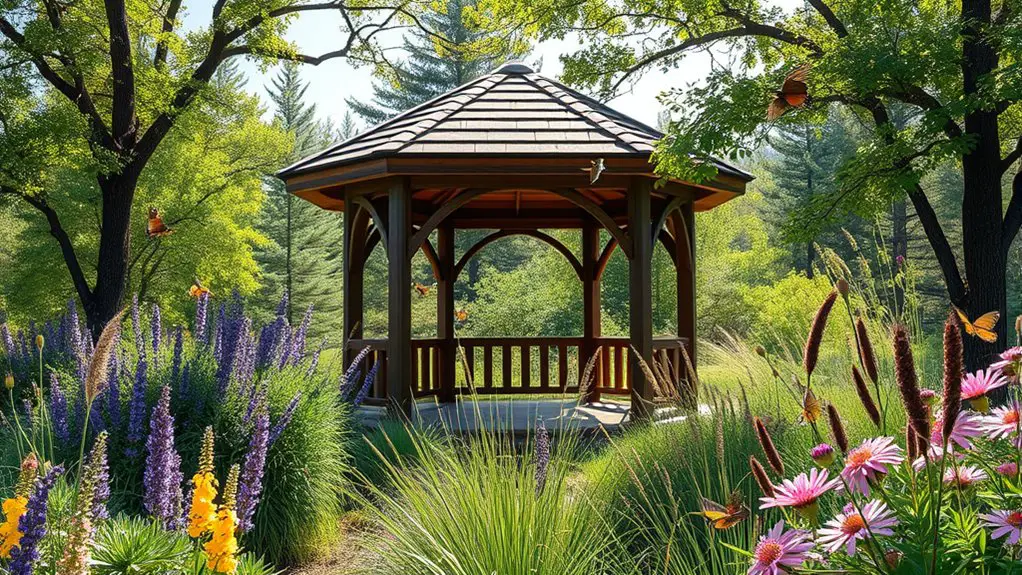To create a wildlife-friendly gazebo area, start by placing your gazebo in a spot that balances sunlight and wind protection. Incorporate native plants that attract pollinators, like coneflowers and milkweeds, for continuous food sources. Adding water features, such as bird baths or ponds, enhances biodiversity while surrounding them with plants for shelter. Use sustainable materials in your design and create nesting areas for birds and insects. Discover how to fully optimize your space for local wildlife.
Choosing the Right Location for Your Gazebo
When selecting the perfect spot for your gazebo, it’s crucial to contemplate not only aesthetics but also the impact on local wildlife. Look for a location that balances sunlight exposure and wind protection; this not only enhances your comfort but also creates a welcoming microhabitat for birds and beneficial insects. Ideally, position your gazebo in a way that allows morning sunlight to warm the space while providing shade during the afternoon heat. Consider natural windbreaks like trees or shrubs to shield your gazebo from harsh gusts, ensuring a tranquil environment. By integrating these elements, you’re not just creating a cozy retreat for yourself but also a sustainable sanctuary for nature, allowing you the freedom to enjoy the outdoors responsibly. Additionally, ideal placement should be on flat, sturdy ground for stability, considering privacy, sun exposure, wind direction, and accessibility.
Incorporating Native Plants for Wildlife Attraction
To create a vibrant wildlife-friendly gazebo area, incorporating native plants is vital, as they provide the food and habitat that local wildlife relies on. Focus on native flower selection to guarantee your garden flourishes sustainably. Here are three key elements to take into account:
Incorporating native plants is essential for a thriving, wildlife-friendly gazebo garden that supports local ecosystems.
- Diversity: Choose a mix of flowering plants that bloom at different times, ensuring a continuous food source for pollinators and other wildlife.
- Pollinator Friendly Plants: Prioritize species like coneflowers, black-eyed Susans, and milkweeds to attract bees, butterflies, and hummingbirds, enhancing biodiversity.
- Soil Health: Opt for plants that enrich the soil, reducing the need for fertilizers while supporting a thriving ecosystem.
Adding Water Features to Enhance Biodiversity
While adding water features to your gazebo area might seem like a decorative choice, it greatly enhances biodiversity by providing essential habitats for various species. Incorporating elements like bird baths and pond ecosystems can attract a wide range of wildlife. Bird baths not only quench the thirst of feathered friends but also serve as a cleaning station, promoting healthy plumage. Meanwhile, a well-designed pond ecosystem fosters a natural habitat for amphibians, insects, and aquatic plants, creating a balanced environment. To maximize the impact, consider adding native plants around these water features, offering shelter and food sources. Additionally, ensuring adequate ventilation in your gazebo area can further support a thriving ecosystem. By embracing these sustainable elements, you’re not just beautifying your space; you’re contributing to a thriving ecosystem that fosters freedom for all its inhabitants.
Utilizing Sustainable Materials in Your Design
Incorporating water features not only enhances biodiversity but also sets the stage for considering the materials used in your gazebo area. To create a truly sustainable design, think about these key elements:
Incorporating water features enriches biodiversity and prompts thoughtful material choices for a sustainable gazebo design.
- Recycled Materials: Use reclaimed wood or metal; they reduce waste and add character.
- Eco-Friendly Finishes: Opt for non-toxic stains or paints that protect the environment while beautifying your space.
- Natural Stone: Incorporate locally sourced stone for pathways or bases; it blends seamlessly with nature and minimizes transportation impact. Additionally, choosing naturally resistant wood can help ensure your gazebo withstands the elements while remaining eco-friendly.
Creating Shelter and Nesting Areas for Wildlife
Creating shelter and nesting areas for wildlife is essential if you want to encourage biodiversity in your gazebo area. By incorporating various shelter types and nesting materials, you’ll create a thriving ecosystem. Consider using birdhouses, bat boxes, and brush piles as shelter types. For nesting materials, you can provide straw, dried leaves, and twigs to attract a variety of species.
| Shelter Type | Nesting Material | Benefits |
|---|---|---|
| Birdhouses | Straw | Attracts songbirds |
| Bat Boxes | Dried Leaves | Supports bat populations |
| Brush Piles | Twigs | Provides cover for small mammals |
| Insect Hotels | Pine Cones | Encourages pollinators like bees and butterflies |
| Log Piles | Moss | Offers habitat for amphibians and reptiles |
Frequently Asked Questions
What Types of Wildlife Are Most Attracted to Gazebo Areas?
When considering wildlife attraction, you’ll find various bird species flocking to your gazebo area, seeking shelter and food. Additionally, numerous insect visitors, like butterflies and bees, enhance the ecosystem, contributing to a vibrant, sustainable environment.
How Can I Maintain My Gazebo Without Harming Wildlife?
To maintain your gazebo sustainably, use eco-friendly materials for repairs, apply natural cleaning solutions to avoid chemicals, and guarantee your upkeep methods support local wildlife. Respect nature’s balance, and you’ll create a harmonious outdoor space.
Are There Specific Plants to Avoid When Creating a Wildlife-Friendly Area?
When creating a wildlife-friendly area, avoid invasive species and toxic plants that can harm local fauna. Opt for native flora that supports biodiversity, ensuring your space thrives sustainably while fostering a harmonious relationship with nature.
How Do I Prevent Pests From Invading My Gazebo Space?
To prevent pests invading your space, consider using natural repellents like essential oils and installing pest barriers such as fine mesh screens. These strategies maintain your area’s integrity while promoting a sustainable, pest-free environment.
Can I Use Lighting in My Wildlife-Friendly Gazebo Area?
Sure, you can use solar lighting for subtle, sustainable ambient illumination. Aim for soft, soothing styles that enhance the atmosphere without disturbing wildlife. It’ll create a calming, cozy space while respecting nature’s needs.

